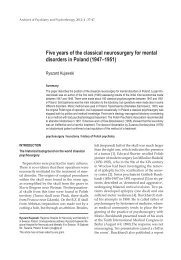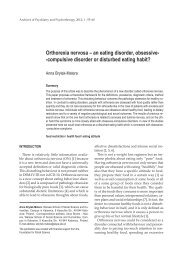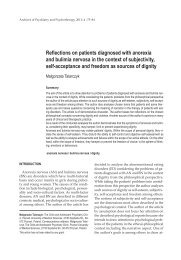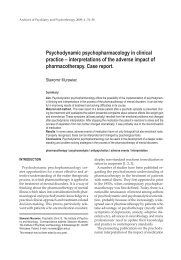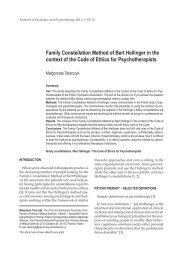Self perception among patients with multiple sclerosis - Archives of ...
Self perception among patients with multiple sclerosis - Archives of ...
Self perception among patients with multiple sclerosis - Archives of ...
Create successful ePaper yourself
Turn your PDF publications into a flip-book with our unique Google optimized e-Paper software.
<strong>Archives</strong> <strong>of</strong> Psychiatry and Psychotherapy, 2010; 3 : 63–68<br />
INTRODUCTION<br />
Karolina Korwin-Piotrowska 1 , Teresa Korwin-Piotrowska 2 , Jerzy<br />
Samochowiec 1 : 1 Department <strong>of</strong> psychiatry, pomeranian Medical University,<br />
Szczecin, Poland. 2 Department <strong>of</strong> Neurology, pomeranian<br />
Medical University, Szczecin, Poland. Correspondence address:<br />
Karolina piotrowska, Klinika psychiatrii pAM, ul. broniewskiego 26,<br />
Szczecin, Poland. E-mail: karaluha@o2.pl<br />
this research has not been aided by any grant.<br />
<strong>Self</strong> <strong>perception</strong> <strong>among</strong> <strong>patients</strong> <strong>with</strong> <strong>multiple</strong><br />
<strong>sclerosis</strong><br />
Karolina Korwin-piotrowska, teresa Korwin-piotrowska,<br />
Jerzy Samochowiec<br />
Summary<br />
Aim. the aim <strong>of</strong> this study was to describe self <strong>perception</strong> <strong>among</strong> <strong>patients</strong> <strong>with</strong> <strong>multiple</strong> <strong>sclerosis</strong> and<br />
asses if it correlates <strong>with</strong> the degree <strong>of</strong> disability.<br />
Method. 63 <strong>patients</strong> took part in this study – all fulfilled McDonald criteria <strong>of</strong> <strong>multiple</strong> <strong>sclerosis</strong>. Disability<br />
was quantified using the Expanded Disability Status Scale (EDSS) by Kurtzke. <strong>Self</strong> <strong>perception</strong> was estimated<br />
by Adjective Check List (ACL, Gough and Heilbrunn), which was divided into two parts: actual self<br />
<strong>perception</strong> and self <strong>perception</strong> before developing SM.<br />
Result. the population <strong>of</strong> <strong>patients</strong> <strong>with</strong> Multiple Sclerosis is characterised by low self-esteem, decreased selfacceptance,<br />
resignation, despair and apprehension. these people tend to restrict or <strong>with</strong>draw from interpersonal<br />
relationships, stop creating new challenges and aims and as a result their life slowly starts to concentrate<br />
mostly on observing symptoms <strong>of</strong> the illness. Another trend observed in this group is looking for support,<br />
protection and attention – which is connected <strong>with</strong> coming into dependency from other people.<br />
Multiple Sclerosis / self <strong>perception</strong> / ACl / disability<br />
Multiple Sclerosis (MS) is a neurological degenerative<br />
illness <strong>of</strong> unknown aetiology, occurring<br />
mostly between the age <strong>of</strong> 20 and 40 years<br />
[1]. The clinical picture <strong>of</strong> the disease consists<br />
<strong>of</strong> demyelination areas located in white matter<br />
<strong>of</strong> central nervous system <strong>with</strong> inflammation<br />
and oedema <strong>of</strong> the axons. There are three main<br />
courses <strong>of</strong> MS: primary progressive, secondary<br />
progressive and relapsing and remitting one; the<br />
last one <strong>of</strong> which carries the best prognosis.<br />
It is obvious, that neurological symptoms are<br />
not the only ones developing in <strong>patients</strong> <strong>with</strong><br />
<strong>multiple</strong> <strong>sclerosis</strong>. Several studies focused on<br />
estimating mood disturbances, cognitive problems,<br />
psychotic episodes in the course <strong>of</strong> MS or<br />
the quality <strong>of</strong> life in <strong>patients</strong> suffering from the<br />
disease. However, there are only a few research<br />
studies concentrated on the self-picture <strong>of</strong> people<br />
suffering from MS.<br />
<strong>Self</strong> <strong>perception</strong> is a set <strong>of</strong> features, which one<br />
identifies <strong>with</strong>. Such a self-picture is created<br />
and modified throughout the lifetime. It consists<br />
<strong>of</strong> convictions about one’s general appearance,<br />
physical and intellectual condition, abilities,<br />
activity, social position, attractiveness, individual<br />
needs, moral regulations, etc. The most<br />
important activity <strong>of</strong> self <strong>perception</strong> is conducting<br />
activities aiming to protect, keeping and developing<br />
one’s ego. Proper functioning <strong>of</strong> this<br />
system is available when three basic psychological<br />
needs are guaranteed: the need <strong>of</strong> keeping<br />
one’s identity, self esteem and control over the<br />
surroundings.
64 Karolina Korwin-Piotrowska et al.<br />
Serious disabling disease and its consequences<br />
are such a strong stress, that changes in self<br />
<strong>perception</strong> are very sudden and not compatible<br />
<strong>with</strong> how it developed so far. In this context the<br />
illness might be compared to a cataclysm which<br />
changes everything. The ill person stops receiving<br />
feedback information which previously confirmed<br />
his identity, self esteem and control. A<br />
lack <strong>of</strong> this information is perceived as a threat<br />
for ego and leads to over-concentration on one’s<br />
complaints and to distress. A sick person becomes<br />
a specific reference standard for him- or<br />
herself – this behaviour is called an egocentric<br />
type <strong>of</strong> regulation [2].<br />
The aim <strong>of</strong> this study was to describe the self<br />
<strong>perception</strong> <strong>among</strong> <strong>patients</strong> <strong>with</strong> <strong>multiple</strong> <strong>sclerosis</strong><br />
and asses if it correlates <strong>with</strong> the degree<br />
<strong>of</strong> disability.<br />
METHODS AND MATERIAlS<br />
The sample consisted <strong>of</strong> 63 <strong>patients</strong>, recruited<br />
from the <strong>multiple</strong> <strong>sclerosis</strong> out-patient clinic.<br />
There were 27 men and 36 women and the mean<br />
age <strong>of</strong> the <strong>patients</strong> was 42.97 years, and the mean<br />
age at onset <strong>of</strong> SM – 31.13 years. All the <strong>patients</strong><br />
fulfilled the McDonald criteria <strong>of</strong> <strong>multiple</strong> <strong>sclerosis</strong><br />
[3]. Disability was quantified using the Expanded<br />
Disability Status Scale (EDSS) by Kurtz-<br />
Figure 1. ACL Test – mean values<br />
Patients <strong>with</strong> MS achieved the lowest scores in<br />
the following scales: Fav – Number <strong>of</strong> favourable<br />
adjectives, Com – Communality, Cha – Change<br />
and Het – Heterosexuality. The scores in scales:<br />
Ach – Achievement, Aff– Affiliation, S-Cf – <strong>Self</strong>-<br />
ke [4] and the course <strong>of</strong> <strong>multiple</strong> <strong>sclerosis</strong> was<br />
also assessed. <strong>Self</strong> <strong>perception</strong> was estimated by<br />
the Adjective Check List (ACL, Gough and Heilbrunn),<br />
which was divided into two parts: actual<br />
self <strong>perception</strong> and self <strong>perception</strong> before developing<br />
SM [5]. ACL is a self-administered questionnaire,<br />
composed <strong>of</strong> 37 adjective scales.<br />
The exclusion affected <strong>patients</strong>, who:<br />
– were treated <strong>with</strong> steroids, β-interferon, anti-depressive<br />
or neuroleptic drugs during the<br />
last four weeks;<br />
– fulfilled criteria <strong>of</strong>: dementia, affective and/or<br />
anxiety disorders <strong>of</strong> moderate or severe degree –<br />
in the past; psychoactive substance addiction;<br />
– were suffering from any systemic diseases<br />
which might have disturbed the natural<br />
course <strong>of</strong> SM.<br />
The statistic analysis methods used in the<br />
present study consisted <strong>of</strong> Kołmogorow-<br />
Smirnow test, variation analysis test (ANO-<br />
VA), and t-student test. The assessment <strong>of</strong> relation<br />
between non-continuous variables was<br />
performed by Spearman’s rank correlation and<br />
Pearson’s correlation. The results were presented<br />
<strong>with</strong> the use <strong>of</strong> correlation factor – r, and probability<br />
– p.<br />
RESUlTS<br />
<strong>Self</strong> <strong>perception</strong><br />
confidence , P-Adj – Personal Adjustment and<br />
Fc – Free child scale significantly decreased,<br />
whereas higher scores were reached in scales:<br />
Suc – Succorance, Aba – Abasement, Def – Deference,<br />
Crs – Counselling Readiness, S-Cn – <strong>Self</strong>control<br />
and Ac – Adapted child.<br />
<strong>Archives</strong> <strong>of</strong> Psychiatry and Psychotherapy, 2010; 3 : 63–68
<strong>Self</strong> <strong>perception</strong> <strong>among</strong> <strong>patients</strong> <strong>with</strong> <strong>multiple</strong> <strong>sclerosis</strong> 65<br />
Table 1. the relation between self picture and disability degree, controlling gender and age<br />
2 factor analysis <strong>of</strong> variation, concomitant variable – age<br />
2-factor<br />
1-factor EDSS Interaction regression score<br />
Variable p level p level p level variable r p level<br />
No Gender 0.93387 0.32781 0.57188 Age -0.02 0.87294<br />
Fav Gender 0.38427 0.38053 0.44559 Age -0.23 0.08687<br />
Uf Gender 0.18848 0.18352 0.49703 Age 0.10 0.46471<br />
Com Gender 0.22674 0.38079 0.55838 Age -0.03 0.82376<br />
Ach Gender 0.02770 0.56723 0.86673 Age -0.11 0.39609<br />
Dom Gender 0.23866 0.37154 0.41205 Age -0.22 0.09207<br />
End Gender 0.05363 0.75764 0.56246 Age -0.09 0.51651<br />
Ord Gender 0.00711 0.22461 0.11979 Age -0.10 0.44729<br />
Int Gender 0.48330 0.69443 0.53240 Age -0.09 0.51417<br />
Nur Gender 0.50058 0.94217 0.43880 Age -0.07 0.62036<br />
Aff Gender 0.26972 0.69804 0.30654 Age -0.28 0.03593<br />
Het Gender 0.42890 0.50090 0.44907 Age -0.38 0.00352<br />
Exh Gender 0.73976 0.72215 0.42943 Age -0.33 0.01271<br />
Aut Gender 0.83352 0.74108 0.89756 Age -0.11 0.39663<br />
Agg Gender 0.87232 0.89713 0.81111 Age -0.14 0.31077<br />
Cha Gender 0.35072 0.02610 0.24695 Age -0.14 0.30558<br />
Suc Gender 0.21618 0.05600 0.57812 Age 0.23 0.08791<br />
Aba Gender 0.28722 0.04185 0.15722 Age 0.27 0.03929<br />
Def Gender 0.93005 0.85504 0.65530 Age 0.18 0.17166<br />
Crs Gender 0.00069 0.20820 0.49987 Age 0.28 0.03476<br />
S-Cn Gender 0.21222 0.85983 0.91276 Age 0.19 0.16044<br />
S-Cf Gender 0.24373 0.29032 0.63112 Age -0.26 0.05068<br />
p-Adj Gender 0.75345 0.26259 0.87011 Age -0.21 0.11279<br />
Iss Gender 0.10244 0.16635 0.29584 Age -0.17 0.19917<br />
Cps Gender 0.51310 0.09213 0.87799 Age -0.27 0.04186<br />
Mls Gender 0.19055 0.51981 0.79874 Age -0.10 0.44844<br />
Mas Gender 0.30497 0.81622 0.21743 Age -0.05 0.68579<br />
Fem Gender 0.47735 0.86161 0.72009 Age -0.18 0.18178<br />
Cp Gender 0.41431 0.40859 0.64319 Age 0.01 0.95079<br />
Np Gender 0.96936 0.53203 0.16466 Age -0.13 0.33206<br />
A Gender 0.28679 0.97633 0.22138 Age -0.02 0.89782<br />
Fc Gender 0.96056 0.13633 0.80631 Age -0.34 0.00897<br />
Ac Gender 0.14443 0.48104 0.36973 Age 0.17 0.20738<br />
AA-1 Gender 0.16480 0.72430 0.34953 Age -0.07 0.60414<br />
AA-2 Gender 0.18458 0.63828 0.94551 Age -0.02 0.87967<br />
AA-3 Gender 0.14344 0.64960 0.36992 Age -0.08 0.56127<br />
AA-4 Gender 0.08554 0.94255 0.53722 Age -0.06 0.66066<br />
<strong>Archives</strong> <strong>of</strong> Psychiatry and Psychotherapy, 2010; 3 : 63–68
66 Karolina Korwin-Piotrowska et al.<br />
The degree <strong>of</strong> disability is related to the need<br />
<strong>of</strong> change, the need <strong>of</strong> abasement and the need<br />
<strong>of</strong> succorance.<br />
In the group <strong>of</strong> <strong>patients</strong> <strong>with</strong> MS, a small disability<br />
(EDSS: 0 – 1.5) causes an increase in the<br />
need <strong>of</strong> change. As the disease progresses, the<br />
need <strong>of</strong> change decreases up to EDSS=4; then it<br />
rises slowly again.<br />
The need <strong>of</strong> abasement tends to decrease according<br />
to the progress <strong>of</strong> illness and the increasing<br />
degree <strong>of</strong> disability. The same is observed for<br />
Figure 2. the relation between need <strong>of</strong> change (Cha) and disability degree<br />
the need <strong>of</strong> succorance – which is presented [in<br />
the Fig.4] next page.<br />
Figure 3. the relation between need <strong>of</strong> abasement (Aba) and disability degree<br />
<strong>Archives</strong> <strong>of</strong> Psychiatry and Psychotherapy, 2010; 3 : 63–68
DISCUSSION<br />
A small amount <strong>of</strong> positive adjectives and –<br />
what is more important – the majority <strong>of</strong> negative<br />
adjectives, represent the low self-esteem<br />
<strong>of</strong> <strong>patients</strong> <strong>with</strong> <strong>multiple</strong> <strong>sclerosis</strong>, decreased<br />
self-acceptance, resignation, despair and apprehension.<br />
This population is lacking in self-trust<br />
– which is expressed by low scores in the selfconfidence<br />
scale. MS <strong>patients</strong> tend to restrict or<br />
<strong>with</strong>draw from interpersonal relationships –<br />
which is manifested by decreased scores in communality,<br />
affiliation and heterosexuality scale.<br />
Reduced scores in achievement and change<br />
scales illustrate <strong>patients</strong>’ deficiency in motivation<br />
to implement plans for life, their shortage<br />
<strong>of</strong> verve and fantasy. They stop to create new<br />
challenges and aims and turn to be more passive<br />
and less enterprising. Slowly their life starts<br />
to focus on observing symptoms <strong>of</strong> the illness,<br />
which in consequence increases the level <strong>of</strong> fear<br />
and threat. High scores in:<br />
Succorance, Deference, Counselling Readiness,<br />
<strong>Self</strong>-control and Adapted child scales mean a<br />
distinct trend <strong>of</strong> looking for support, protection<br />
and attention. There is also an observed evident<br />
difficulty in fulfilling their obligations or social<br />
roles, which is connected <strong>with</strong> coming into dependency<br />
from other people. Patients <strong>with</strong> MS<br />
feel unable to overcome stress, they have an inclination<br />
to indulge in fantasies – <strong>of</strong>ten connected<br />
<strong>with</strong> consciousness <strong>of</strong> guilt and helplessness.<br />
A significantly increased score on Abasement<br />
<strong>Self</strong> <strong>perception</strong> <strong>among</strong> <strong>patients</strong> <strong>with</strong> <strong>multiple</strong> <strong>sclerosis</strong> 67<br />
Figure 4. the relation between need <strong>of</strong> succorance (Suc) and disability degree.<br />
<strong>Archives</strong> <strong>of</strong> Psychiatry and Psychotherapy, 2010; 3 : 63–68<br />
scale should be treated as a manifestation <strong>of</strong> self<br />
depreciation.<br />
Very similar results were obtained by Papuć<br />
and Pawłowska, who have examined a group <strong>of</strong><br />
42 <strong>patients</strong> <strong>with</strong> Multiple Sclerosis. Apart from<br />
the features mentioned above, they focused on<br />
significantly decreased scores on the Creative<br />
Personality scale – which represent restriction<br />
<strong>of</strong> creativity and disinterest in how their lives<br />
are actively created [6].<br />
Definitely an unlike population <strong>of</strong> <strong>patients</strong> is<br />
a group <strong>of</strong> <strong>patients</strong> <strong>with</strong> cardiac transplantation,<br />
investigated by Nasiłowska-Barud. These <strong>patients</strong><br />
have achieved an average level <strong>of</strong> a need<br />
for achievement (Ach), a need for domination<br />
(Dom), not resigning from a leading role and a<br />
need <strong>of</strong> endurance (End) in grappling <strong>with</strong> life<br />
difficulties. Their social needs also remain moderate,<br />
which is manifested by average scores on<br />
scales <strong>of</strong> affiliation, Heterosexuality and Exhibitionist.<br />
A decrease was observed only <strong>with</strong><br />
regard to the need for Autonomy and making<br />
Changes, which – similarly to <strong>patients</strong> <strong>with</strong> MS –<br />
means a decreased need for acting autonomously<br />
and lack <strong>of</strong> initiative in creating new plans or<br />
even making any decisions [7].<br />
The fact <strong>of</strong> changes in self-<strong>perception</strong> concerns<br />
most <strong>patients</strong> <strong>with</strong> chronic diseases. The<br />
low self-confidence – as a characteristic feature<br />
– was described by MJ Fischer in a group <strong>of</strong> <strong>patients</strong><br />
<strong>with</strong> chronic pulmonary diseases [8]. A<br />
similar observation was made by R Ziechen in<br />
a group <strong>of</strong> <strong>patients</strong> <strong>with</strong> diabetes mellitus and
68 Karolina Korwin-Piotrowska et al.<br />
chronic hepatitis [9] and by I Fuhrmann and R<br />
Krause <strong>with</strong> regard to <strong>patients</strong> <strong>with</strong> chronic kidney<br />
disease [10].<br />
A lack <strong>of</strong> sense <strong>of</strong> autonomy was mentioned<br />
by Simon, while characterising a group <strong>of</strong> 67 <strong>patients</strong><br />
suffering from phenylketonuria [11].<br />
Deficiency in sense <strong>of</strong> security, resulting in disability<br />
<strong>of</strong> verbalising negative emotions (especially<br />
anger), was noticed by many authors dealing<br />
<strong>with</strong> cancer problems, particularly <strong>among</strong><br />
<strong>patients</strong> <strong>with</strong> breast cancer [12, 13].<br />
The disease activity has an irrefutable influence<br />
on self-<strong>perception</strong> <strong>among</strong> <strong>patients</strong> suffering<br />
from <strong>multiple</strong> <strong>sclerosis</strong>. The level <strong>of</strong> disability<br />
was related to the need <strong>of</strong> change, abasement<br />
and succorance.<br />
In our group <strong>of</strong> 63 <strong>patients</strong> <strong>with</strong> MS, a low<br />
degree <strong>of</strong> disability is connected <strong>with</strong> an increased<br />
need <strong>of</strong> change. As the illness progresses,<br />
the need for change decreases – until an advanced<br />
phase <strong>of</strong> the disease, when it rises again.<br />
We might infer that the beginning <strong>of</strong> <strong>multiple</strong><br />
<strong>sclerosis</strong> is a stage <strong>of</strong> fighting against the illness<br />
and trying to find one’s place in a new reality,<br />
which is connected <strong>with</strong> the necessity <strong>of</strong> creating<br />
new solutions. The next phase is the phase<br />
<strong>of</strong> resignation, looking for stabilisation and tendency<br />
to avoid risk. The last stage <strong>of</strong> the disease<br />
appears when a patient is adapted to his new<br />
role <strong>of</strong> an ill person and his or her sense <strong>of</strong> control<br />
increases.<br />
The beginning <strong>of</strong> the disease, regardless <strong>of</strong><br />
how low the disability degree is, induces an increase<br />
<strong>of</strong> the need <strong>of</strong> abasement. A conclusion<br />
might be drawn that the fact <strong>of</strong> becoming ill<br />
causes such depreciation <strong>of</strong> self esteem. As the<br />
patient gets accustomed to illness, his or her self<br />
esteem slowly rebuilds. When considering the<br />
need <strong>of</strong> succorance – a very similar process takes<br />
place.<br />
The changes described above clearly indicate<br />
that strategies <strong>of</strong> dealing <strong>with</strong> the illness<br />
which are used by SM <strong>patients</strong> are not effective<br />
enough. This result underlines an obvious need<br />
for specialist care – both psychiatric and psychological<br />
[14]. This care would help <strong>patients</strong> to accept<br />
their disease and create strategies <strong>of</strong> dealing<br />
<strong>with</strong> the illness – mostly through learning how<br />
to control the pain, disability and situation.<br />
REFERENCES<br />
1. Amato Mp, ponziani G, rossi F, Liedl CL, Stefanile C, rossi<br />
L. Quality <strong>of</strong> life in <strong>multiple</strong> <strong>sclerosis</strong>: the impact <strong>of</strong> depression,<br />
fatigue and disability. Multiple Sclerosis, 2001; 7, 340-344.<br />
2. reykowski J. Some <strong>of</strong> the integration and regulation forms <strong>of</strong><br />
personality (in Polish). Psychologia Wych. 1971; 14, 285–300.<br />
3. McDonald WI, Compston A, Edgar G, et al. recommended<br />
criteria for Multiple Sclerosis: guidelines from International<br />
panel on the Diagnosis <strong>of</strong> Multiple Sclerosis. Ann. Neurol.<br />
2001; 50, 121–127.<br />
4. Kurtzke J. Rating Neurologic impairment in <strong>multiple</strong> <strong>sclerosis</strong>:<br />
An expanded disability status scale (EDSS). Neurol. 1983;<br />
33, 1444–1452.<br />
5. Matkowski M. Adjective check list as an instrument for measuring<br />
human needs (in Polish). Przegląd psychologiczny<br />
1984; 2: 519–536.<br />
6. Papuć E, Pawłowska B. Personality features in <strong>multiple</strong> <strong>sclerosis</strong><br />
<strong>patients</strong> <strong>with</strong> a relapsing-remitting course <strong>of</strong> the disease.<br />
Psychiatria Polska 2005; 4, 669–678.<br />
7. Nasidłowska – Barud A. Selected psychological problems <strong>of</strong><br />
<strong>patients</strong> <strong>with</strong> cardiac transplantation on a permanent pacing<br />
treatment. Annales Universitatis Maria Curie – Skłodowska,<br />
Lublin – Polonia: Sectio D; 2003; 2: 162.<br />
8. Fischer MJ, Scharloo M, Abbink JJ, thijs-Van A, rudolphus<br />
A, Snoei L, Weinman JA, Kaptein AA. participation and dropout<br />
in pulmonary rehabilitation: a qualitative analysis <strong>of</strong> the<br />
patient’s perspective. Clinical Rehabilitation 2007; 21(3):<br />
212–221.<br />
9. Zeichen R. Vergleichende Untersuchungen über die Persönlichkeitsstruktur<br />
des Diabetikers und des chronisch Leberkranken.<br />
Wiener Medizinische Wochenschrift. Supplement.<br />
1986; 96: 1–12.<br />
10. Fuhrmann I, Krause r. principles <strong>of</strong> exercising in <strong>patients</strong><br />
<strong>with</strong> chronic kidney disease, on dialysis and for kidney transplant<br />
recipients. Clinical Nephrology 2004; 1: 14–25.<br />
11. Simon E, Schwarz M, roos J, Dragano N, Geraedts M,<br />
Siegrist J, Kamp G, Wendel U. Evaluation <strong>of</strong> quality <strong>of</strong> life<br />
and description <strong>of</strong> the sociodemographic state in adolescent<br />
and young adult <strong>patients</strong> <strong>with</strong> phenylketonuria (pKU). Health<br />
and Quality <strong>of</strong> Life Outcomes 2008; 6: 25.<br />
12. Cardenal V, Ortiz-tallo M, Martin Frias I, Martinez Lozano J.<br />
Life stressors, emotional avoidance and breast cancer. The<br />
Spanish Journal <strong>of</strong> Psychology 2008; 2: 522–530.<br />
13. Lieberman MA, Goldstein BA. Not all negative emotions<br />
are equal: the role <strong>of</strong> emotional expression in online support<br />
groups for women <strong>with</strong> breast cancer. psychooncology<br />
2006; 2: 160–168.<br />
14. Jopson M. Nicola, Moss – Morris R. The role <strong>of</strong> illness severity<br />
and illness representations in adjusting to <strong>multiple</strong><br />
<strong>sclerosis</strong>. Journal <strong>of</strong> Psychosomatic Research 2003; 54:<br />
503–511.<br />
<strong>Archives</strong> <strong>of</strong> Psychiatry and Psychotherapy, 2010; 3 : 63–68



